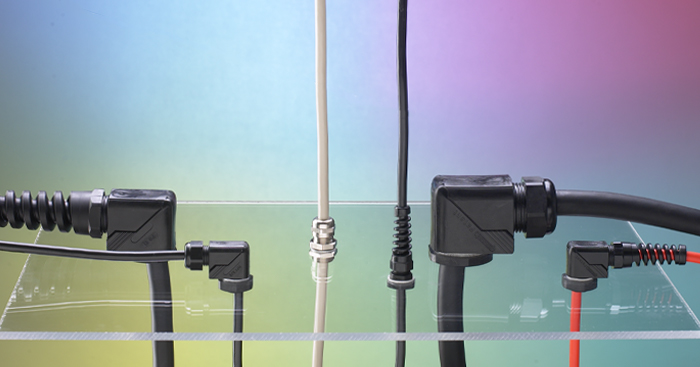Protecting Global Electrical Connections with Metric Strain Reliefs/Cable Glands
Posted on 7/1/19 9:47 AM

A strain relief or cable gland extends cord life and reinforces the cord connection to the equipment. The main purpose is to help protect the electrical connection and circuitry inside the equipment. The most common application is on a power cord providing electricity to equipment. In many situations, the equipment is portable and requires protection so the cable cannot be pulled out of the equipment.
“A strain relief/cable gland provides an important mechanical anchor for the power cord, preventing torque and tensile stresses along the flexible cord reaching internal connections,” explained Dan Ford, Technical Support Specialist at Interpower®. “It can also seal the power cord entry hole from external liquid and particles.”
The term “strain relief” is commonly used in North America, while “cable gland” is commonly used throughout Europe and other parts of the world.
Types of Strain Reliefs/Cable Glands
Interpower offers three different types of mounting threads in the strain relief/cable gland product line. These include: NPT (National Pipe Thread) which is the American standard; PG (Panzer-Gewinde) which is the European standard; and M (metric), which is a general purpose thread used worldwide. The thread system chosen depends on the location the equipment will be used. For example, if the market is in North America, choose from the NPT series or the metric series. If it is in the European Union, choose metric ones for new equipment and installations. The PG thread is typically for replacement parts for existing installations.
There are two main styles of strain reliefs/cable glands offered by Interpower: dome and flex. “The dome style is designed to protect the wire entering the equipment. It helps to secure the wire connection to the equipment and provide longer life to the cord by preventing it from rubbing against a rough or sharp edge where the cord passes through the equipment panel,” Dan explained. “The flex style provides cable bend relief protection to the cord entering the equipment. The spiral shaped spring wraps around the cord and adds strength to the cord where it is more vulnerable to damage. This helps to minimize the chance of broken stranded conductors at the enclosure entry point, which can result in loss of continuity or arcing.”
Metric Strain Reliefs/Cable Glands
Metric strain reliefs/cable glands can be used worldwide. The threads have a slightly different pattern than NPT and PG threads. Metric patterns are identified with an “M” and the thread size, followed by the thread pitch, which is the distance between the threads. For example: M12 x 1.5mm indicates a diameter of 12mm and a thread pitch of 1.5mm (or 1.5mm between each thread “crest” or peak). The diameter is a measurement across the hole or bolt, including the threads.
Factors to consider when determining which metric strain relief/cable gland is best: thread type and size, cable range (outer diameter), and threaded or non-threaded hole.
- Thread type and size—Thread size will depend on the thread type, cable diameter, and the equipment manufacturer’s preferences.
- Cable range (outer diameter)—By choosing a metric strain relief/cable gland that can be used on both a North American power cord and an international power cord, it will allow an equipment manufacturer to specify one strain relief/cable gland for global export.|
For example: Interpower part number 85820910 is a metric strain relief/cable gland with a thread type of M16 x 1.5mm and a cable diameter of 4.0mm to 8.0mm. This part can be used on both a 3x18AWG SJT power cord with an outer diameter of 7.8mm (P/N 70401000244) and a H05VV-F 1.00mm2 power cord with an outer diameter of 6.3mm to 8.0mm (P/N 86230020). - Threaded or non-threaded hole—If using a non-threaded hole, the application will require the locking nut, which is included with each strain relief/cable gland.
Metric Strain Reliefs/Cable Glands offered by Interpower
Within the Interpower strain relief/cable gland product line, the following types have metric choices: liquid tight dome nut, nickel-plated brass dome nut, nickel-plated brass mini dome nut, and liquid tight flex style.
Liquid Tight Dome Nut
| Part Number | Cable Diameter | Thread Type | Mounting Hole |
|---|---|---|---|
| 85820900 | 3.0mm to 6.5mm | M12 x 1.5mm | 12.0mm |
| 85820910 | 4.0mm to 8.0mm | M16 x 1.5mm | 16.0mm |
| 85820920 | 6.0mm to 12.0mm | M20 x 1.5mm | 20.0mm |
Nickel-Plated Brass Dome Nut
| Part Number | Cable Diameter | Thread Type | Mounting Hole |
|---|---|---|---|
| 85824920 | 4.0mm to 6.0mm | M10 x 1.5 mm | 10.0mm |
| 85824930 | 3.0mm to 6.5mm | M12 x 1.5mm | 12.0mm |
| 85824950 | 4.0mm to 8.0mm | M16 x 1.5mm | 16.0mm |
| 85824990 | 6.0mm to 12.0mm | M20 x 1.5mm | 20.0mm |
Nickel-Plated Brass Mini Dome Nut
| Part Number | Cable Diameter | Thread Type | Mounting Hole |
|---|---|---|---|
| 85824900 | 2.0mm to 3.2mm | M6 x 1.0mm | 6.0mm |
| 85824910 | 3.0mm to 5.0mm | M8 x 1.25mm | 8.0mm |
Liquid Tight Flex Style
| Part Number | Cable Diameter | Thread Type | Mounting Hole |
|---|---|---|---|
| 85820370 | 3.0mm to 6.5mm | M12 x 1.5mm | 12.0mm |
| 85820380 | 4.0mm to 8.0mm | M16 x 1.5mm | 16.0mm |
| 85820390 | 6.0mm to 12.0mm | M20 x 1.5mm | 20.0mm |
Additional Resources
For the complete line of strain reliefs/cable glands available through Interpower, see Strain Reliefs/Cable Glands and the Featured Product page.
Interpower offers free technical support. For further assistance, please see Interpower’s contact information below.
Topics: cable, cable glands, strain reliefs




